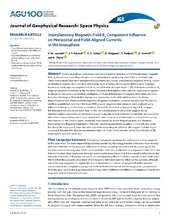| dc.contributor.author | Laundal, Karl Magnus | |
| dc.contributor.author | Reistad, Jone Peter | |
| dc.contributor.author | Finlay, Christopher C. | |
| dc.contributor.author | Østgaard, Nikolai | |
| dc.contributor.author | Tenfjord, Paul | |
| dc.contributor.author | Snekvik, Kristian | |
| dc.contributor.author | Ohma, Anders | |
| dc.date.accessioned | 2019-06-21T13:01:39Z | |
| dc.date.available | 2019-06-21T13:01:39Z | |
| dc.date.issued | 2018-05 | |
| dc.Published | Laundal KM, Reistad JP, Finlay CC, Østgaard N, Tenfjord PAR, Snekvik K, Ohma A. Interplanetary Magnetic Field Bx Component Influence on Horizontal and Field-Aligned Currents in the Ionosphere. Journal of Geophysical Research - Space Physics. 2018;123(5):3360-3379 | eng |
| dc.identifier.issn | 2169-9402 | en_US |
| dc.identifier.issn | 2169-9380 | en_US |
| dc.identifier.uri | https://hdl.handle.net/1956/20343 | |
| dc.description.abstract | Statistical analyses have shown that the sunward component of the interplanetary magnetic field, Bx (Geocentric Solar Magnetospheric), moderately but significantly affects the auroral intensity. These observations have been interpreted as signatures of a similar interplanetary magnetic field Bx control on Birkeland currents yet to be observed directly. Such a control, attributed to differences in magnetic tension on newly opened magnetic field lines, would lead to stronger region 1 (R1) Birkeland currents for Bx negative (positive) conditions in the Northern (Southern) Hemispheres than when Bx is positive (negative). In this paper we perform a detailed investigation of three different sets of magnetic field measurements, from the Challenging Minisatellite Payload and Swarm low Earth orbit satellites, from the Active Magnetosphere and Planetary Electrodynamics Response Experiment products derived from the Iridium satellite constellation, and from the SuperMAG ground magnetometer network, each analyzed using different techniques, to test these predictions. The results show that a change in sign of Bx changes the Birkeland currents by no more than ≈10%. The current patterns show little support for an interhemispheric asymmetry of the kind proposed to explain auroral observations. Instead, we propose an alternative interpretation, which is consistent with most of the auroral observations and with the current observations in the present paper, except for those based on Active Magnetosphere and Planetary Electrodynamics Response Experiment: The solar wind‐magnetosphere coupling is more efficient when the dipole tilt angle and Bx have the same sign than when they are different. We suggest that the higher coupling is because the dayside reconnection region is closer to the subsolar point when the dipole tilt angle and Bx have the same sign. | en_US |
| dc.language.iso | eng | eng |
| dc.publisher | Wiley | en_US |
| dc.rights | Attribution CC BY-NC-ND | eng |
| dc.rights.uri | http://creativecommons.org/licenses/by-nc-nd/4.0/ | eng |
| dc.title | Interplanetary Magnetic Field Bx Component Influence on Horizontal and Field-Aligned Currents in the Ionosphere | en_US |
| dc.type | Peer reviewed | |
| dc.type | Journal article | |
| dc.date.updated | 2019-01-24T11:38:49Z | |
| dc.description.version | publishedVersion | en_US |
| dc.rights.holder | Copyright 2018 The Author(s) | en_US |
| dc.identifier.doi | https://doi.org/10.1002/2017ja024864 | |
| dc.identifier.cristin | 1646398 | |
| dc.source.journal | Journal of Geophysical Research - Space Physics | |

